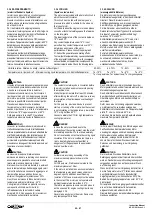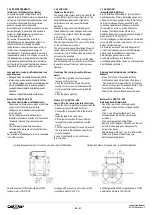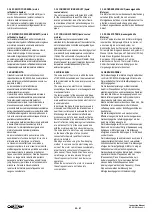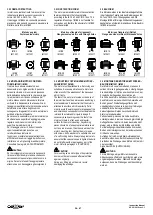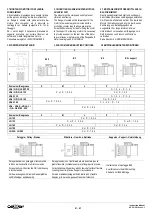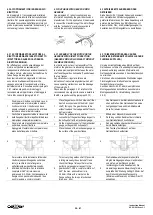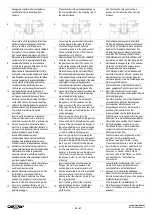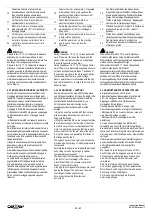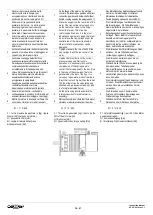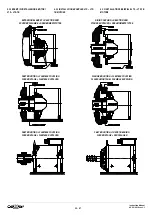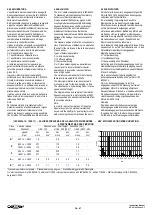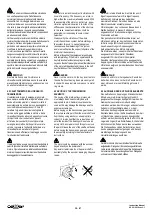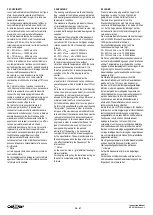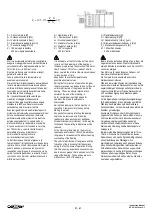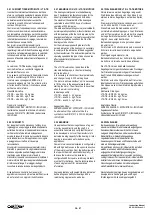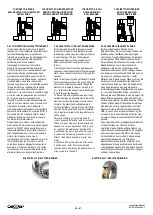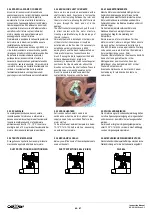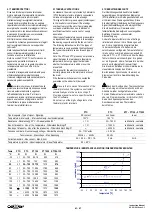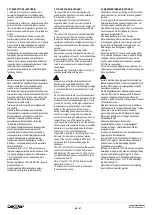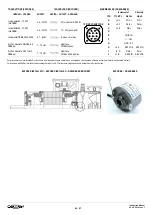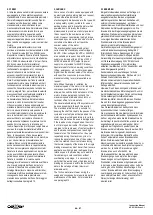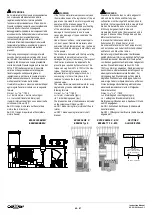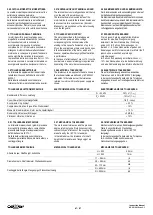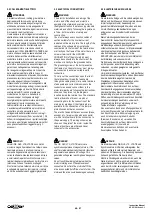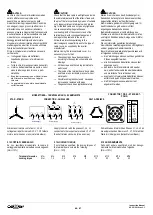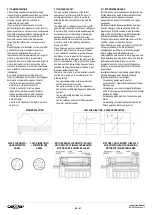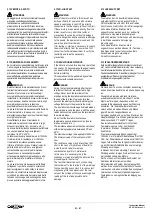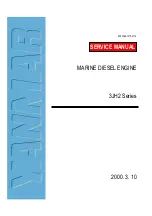
36 - 97
Instruction Manual
AC 02/2019-rev.1.1
5.0 CUSCINETTI
I cuscinetti normalmente utilizzati sono del tipo a
sfere, idonei alle alte velocità e lubrificati con
grassi speciali resistenti a regimi di rotazione e
temperature elevate.
La configurazione standard prevede l’utilizzo di
cuscinetti radiali rigidi a sfere su entrambi i lati.
A richiesta, possono essere montati cuscinetti a
rulli sul lato comando, cuscinetti a sfere di alta
precisione, cuscinetti isolati elettricamente.
La durata massima teorica dei cuscinetti è
calcolata in circa 20.000 ore di funzionamento
continuo a 1500 rpm circa. Per velocità di
rotazione medie più elevate, la vita dei cuscinetti
varia come segue:
30
50% di n
max .
–
16.000 ore circa
50
60% di n
max .
–
12.000 ore circa
60
70% di n
max .
–
8.000 ore circa
I dati e le ore di funzionamento sono calcolati per
utilizzo in condizioni normali, senza vibrazioni e
con temperature che rientrano nei limiti imposti
dai fabbri
canti dei cuscinetti. E’ pertanto possibile
che in determinate situazioni di impiego, la durata
dei cuscinetti possa essere ridotta.
La velocità n
max
è da intendersi come limite
massimo di rotazione e non come velocità
continuativa di utilizzo che è limitata al 70% circa
di n
max
.
Per i motori forniti con l’opzione (cuscinetto a
rulli), il dato velocità massima (n
max
) deve essere
ridotto a causa della minor velocità massima
consentita da questa tipologia di cuscinetti.
Inoltre è richiesto un carico radiale minimo per un
corretto funzionamento. Per maggiori dettagli
consultare il nostro ufficio tecnico.
Per motori forniti con cuscinetti a sfere di
precisione “per mandrini”, (ne
cessari per
consentire l’incremento della velocità massima
indicata nella scheda tecnica), il carico radiale ed
assiale deve essere ridotto in funzione della
massima velocità di funzionamento richiesta. In
questo caso è necessario consultare il ns. ufficio
tecnico per valutare la durata ed il tipo di
lubrificante da utilizzare. Per i motori provvisti di
ingrassatori per la lubrificazione periodica dei
cuscinetti, è necessario rispettare gli intervalli di
rilubrificazione suggeriti dal costruttore.
La temperatura ambiente, la velocità di
funzionamento ed il tipo di lubrificante utilizzato
possono influenzare notevolmente la frequenza
di intervento.
Note:
sul lato opposto comando è sempre montato un
cuscinetto a sfere.
Per accoppiamenti con puleggia il carico radiale
agente sull’albero motore è calcolabile secondo
la formula sotto riportata.
5.0 BEARINGS
The bearing normally used are the ball-bearing
type, suitable for the high speeds and lubricated
with special greases resistant to high rotation and
temperature conditions.
The standard configuration provides for the use
of rigid radial ball-bearings on both sides.
On request, roller bearings on the drive side, high
precision ball bearings, insulated bearings can be
supplied.
The maximum theoretical life of the bearings is
calculated in about 20.000 hours of continuous
operation at 1500 rpm aprox. For higher average
rotation speeds, the life of the bearings varies as
follows:
30
50% of n
max .
–
about 16.000 hours
50
60% of n
max .
–
about 12.000 hours
60
70% of n
max .
–
about 8.000 hours
The data and the operating hours are calculated
for normal operating conditions, without
vibrations and with temperatures within the limits
imposed by the bearing manufacturers. It is
therefore possible that, in particular operating
conditions, the life of the bearing could be
shorter.
The speed n
max
is to be intended as the
maximum limit of rotation and not as continuous
operating speed, which is limited to about 70% of
n
max
.
As to the motors supplied with the (roller bearing)
option, the maximum speed datum (n
max
) must be
reduced due to the lower maximum speed
allowed by this typology of bearings. Moreover, a
minimum radial load for a correct operation.
For further details, please refer to our engineers.
As for motors supplied with precision ball bearing
"for spindles", (necessary in order to allow the
increase of the maximum speed indicated in the
technical sheet), the radial and axial load must be
reduced in function of the requested maximum
operating speed. In this case please refer to our
engineers in order to evaluate the life and the
type of lubrication to be used. For the motors
equipped with greasers for the periodic
lubrication of the bearings, it is necessary to
comply with the lubrication intervals suggested
by the manufacturer. The ambient temperature,
the operating speed and the type of lube oil used
can affect substantially the frequency of the
interventions.
Notes:
on the non drive side, a rigid radial ball bearing is
always installed.
For coupling with pulley, the radial load acting on
the shaft is computable
using the following
formula:
5.0 LAGER
Die normalerweise eingesetzten Lager sind
Kugellager, welche für hohe Drehzahlen
geeignet und mit Spezialfetten für hohe
Temperaturen geschmiert sind. Die
Standardkonfiguration sieht die Verwendung
von starren Radialkugellagern an beiden Seiten
vor. Auf Anfrage können Rollenlager auf der
Antriebsseite oder Hochpräzisionskugellager
verwendet werden.
Die maximale theoretische Lebensdauer der Lager
wird mit 20.000 Stunden Dauerbetrieb bei circa
1500 rpm berechnet. Bei höheren
Durchschnittsdrehzahlen ändert sich die
Lebensdauer der Lager wie folgt:
30 ÷ 50% von nmax - ca. 16.000 Stunden
50 ÷ 60% von nmax - ca. 12.000 Stunden
60 ÷ 70% von nmax - ca. 8.000 Stunden
Die Daten und die Betriebsstunden beziehen sich
auf normale Einsatzbedingungen ohne Vibrationen
und bei Temperaturen, die innerhalb der von den
Lagerherstellern festgelegten Grenzen liegen. Es ist
folglich möglich, dass unter bestimmten
Einsatzbedingungen die Lebensdauer der Lager
herabgesetzt ist.
Die Geschwindigkeit nmax bezeichnet die
maximale Drehzahl und nicht die Dauerdrehzahl,
welche auf circa 70% von nmax begrenzt ist.
Bei den mit (Option) Rollenlager ausgestatteten
Motoren muß die Angabe der Höchstdrehzahl
(nmax) aufgrund der niedrigeren zugelassenen
Höchstdrehzahl bei dieser Lagerart herabgesetzt
werden. Außerdem ist für ein einwandfreies
Funktionieren eine radiale Mindestbelastung
erforderlich. Weitere Details sind von unserer
technischen Abteilung erhältlich.
Bei Motoren, die mit Präzisionslagern „für Spindeln“
(erforderlich, um die Steigerung der Höchstdrehzahl
laut technischer Beschreibung zu ermöglichen)
ausgestattet sind, müssen Radial- und Axiallast in
Funktion der erforderlichen Höchstdrehzahl
herabgesetzt werden. In diesem Fall ist es
notwendig, sich mit unserer technischen Abteilung
über Lebensdauer und Schmiermittel zu beraten.
Bei den mit Schmieranlage ausgestatteten Motoren
zur regelmäßigen Abschmierung der Lager müssen
die vom Hersteller empfohlenen Schmierabstände
eingehalten werden.
Die Umgebungstemperatur, die Betriebsdrehzahlen
und das benützte Schmiermittel können die
Wartungshäufigkeit erheblich beeinflussen.
Hinweis:
Auf der Abtriebsseite ist immer ein Kugellager
montiert.
Für Antriebe mit Riemenscheibe wird die auf die
Antriebswelle wirkende Radialbelastung nach der
folgenden Formel berechnet:

